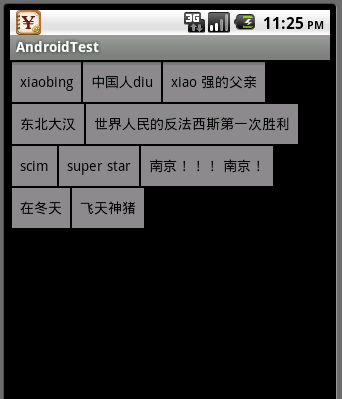viewgroup简单说就是可以装view的view.今天遇到一个问题,就是需要一个可以自动根据一行中view的宽度自动换行的布局,网上 找了下,没有相关的例子,但是找到了思路:自定义一个viewgroup,然后在onlayout文件里面自动检测view的右边缘的横坐标值,和你的 view的parent view的况度判断是否换行显示view就可以了。因为代码比较简单,就不多说了:
1 public class MyViewGroup extends ViewGroup {
2 private final static String TAG = "MyViewGroup";
3
4 private final static int VIEW_MARGIN=2;
5
6 public MyViewGroup(Context context) {
7 super(context);
8 }
9 @Override
10 protected void onMeasure(int widthMeasureSpec, int heightMeasureSpec) {
11 Log.d(TAG, "widthMeasureSpec = "+widthMeasureSpec+" heightMeasureSpec"+heightMeasureSpec);
12
13 for (int index = 0; index < getChildCount(); index++) {
14 final View child = getChildAt(index);
15 // measure
16 child.measure(MeasureSpec.UNSPECIFIED, MeasureSpec.UNSPECIFIED);
17 }
18
19 super.onMeasure(widthMeasureSpec, heightMeasureSpec);
20 }
21
22 @Override
23 protected void onLayout(boolean arg0, int arg1, int arg2, int arg3, int arg4) {
24 Log.d(TAG, "changed = "+arg0+" left = "+arg1+" top = "+arg2+" right = "+arg3+" botom = "+arg4);
25 final int count = getChildCount();
26 int row=0;// which row lay you view relative to parent
27 int lengthX=arg1; // right position of child relative to parent
28 int lengthY=arg2; // bottom position of child relative to parent
29 for(int i=0;i<count;i++){
30
31 final View child = this.getChildAt(i);
32 int width = child.getMeasuredWidth();
33 int height = child.getMeasuredHeight();
34 lengthX+=width+VIEW_MARGIN;
35 lengthY=row*(height+VIEW_MARGIN)+VIEW_MARGIN+height+arg2;
36 //if it can't drawing on a same line , skip to next line
37 if(lengthX>arg3){
38 lengthX=width+VIEW_MARGIN+arg1;
39 row++;
40 lengthY=row*(height+VIEW_MARGIN)+VIEW_MARGIN+height+arg2;
41
42 }
43
44 child.layout(lengthX-width, lengthY-height, lengthX, lengthY);
45 }
46
47 }
48
49 }
这里有个地方要注意,那就要明白ViewGroup的绘图流程:ViewGroup绘制包括两个步骤:1.measure 2.layout
在两个步骤中分别调用回调函数:1.onMeasure() 2.onLayout()
1.onMeasure() 在这个函数中,ViewGroup会接受childView的请求的大小,然后通过childView的 measure(newWidthMeasureSpec, heightMeasureSpec)函数存储到childView中,以便childView的getMeasuredWidth() andgetMeasuredHeight() 的值可以被后续工作得到。
2.onLayout() 在这个函数中,ViewGroup会拿到childView的getMeasuredWidth() andgetMeasuredHeight(),用来布局所有的childView。
3.View.MeasureSpec 与 LayoutParams 这两个类,是ViewGroup与childView协商大小用的。其中,View.MeasureSpec是ViewGroup用来部署 childView用的, LayoutParams是childView告诉ViewGroup 我需要多大的地方。
4.在View 的onMeasure的最后要调用setMeasuredDimension()这个方法存储View的大小,这个方法决定了当前View的大小。
效果图:








 本文介绍如何自定义ViewGroup实现视图自动换行的功能。通过重写onMeasure和onLayout方法,检测子视图宽度并根据父视图宽度判断是否换行。文章提供了一个简单的自定义ViewGroup示例代码。
本文介绍如何自定义ViewGroup实现视图自动换行的功能。通过重写onMeasure和onLayout方法,检测子视图宽度并根据父视图宽度判断是否换行。文章提供了一个简单的自定义ViewGroup示例代码。


















 371
371

 被折叠的 条评论
为什么被折叠?
被折叠的 条评论
为什么被折叠?








